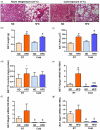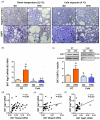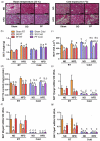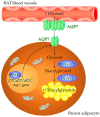Increased Aquaporin-7 Expression Is Associated with Changes in Rat Brown Adipose Tissue Whitening in Obesity: Impact of Cold Exposure and Bariatric Surgery
- PMID: 36834823
- PMCID: PMC9963055
- DOI: 10.3390/ijms24043412
Increased Aquaporin-7 Expression Is Associated with Changes in Rat Brown Adipose Tissue Whitening in Obesity: Impact of Cold Exposure and Bariatric Surgery
Abstract
Glycerol is a key metabolite for lipid accumulation in insulin-sensitive tissues. We examined the role of aquaporin-7 (AQP7), the main glycerol channel in adipocytes, in the improvement of brown adipose tissue (BAT) whitening, a process whereby brown adipocytes differentiate into white-like unilocular cells, after cold exposure or bariatric surgery in male Wistar rats with diet-induced obesity (DIO) (n = 229). DIO promoted BAT whitening, evidenced by increased BAT hypertrophy, steatosis and upregulation of the lipogenic factors Pparg2, Mogat2 and Dgat1. AQP7 was detected in BAT capillary endothelial cells and brown adipocytes, and its expression was upregulated by DIO. Interestingly, AQP7 gene and protein expressions were downregulated after cold exposure (4 °C) for 1 week or one month after sleeve gastrectomy in parallel to the improvement of BAT whitening. Moreover, Aqp7 mRNA expression was positively associated with transcripts of the lipogenic factors Pparg2, Mogat2 and Dgat1 and regulated by lipogenic (ghrelin) and lipolytic (isoproterenol and leptin) signals. Together, the upregulation of AQP7 in DIO might contribute to glycerol influx used for triacylglycerol synthesis in brown adipocytes, and hence, BAT whitening. This process is reversible by cold exposure and bariatric surgery, thereby suggesting the potential of targeting BAT AQP7 as an anti-obesity therapy.
Keywords: adipocyte hypertrophy; aquaglyceroporin; lipogenesis; peroxisome proliferator-activated receptor γ; sleeve gastrectomy.
Conflict of interest statement
The authors declare no conflicts of interest.
Figures







Similar articles
-
Role of aquaporin-7 in ghrelin- and GLP-1-induced improvement of pancreatic β-cell function after sleeve gastrectomy in obese rats.Int J Obes (Lond). 2017 Sep;41(9):1394-1402. doi: 10.1038/ijo.2017.135. Epub 2017 Jun 6. Int J Obes (Lond). 2017. PMID: 28584298
-
Sleeve Gastrectomy Reduces Hepatic Steatosis by Improving the Coordinated Regulation of Aquaglyceroporins in Adipose Tissue and Liver in Obese Rats.Obes Surg. 2015 Sep;25(9):1723-34. doi: 10.1007/s11695-015-1612-z. Obes Surg. 2015. PMID: 25736229
-
Loss of APOO (MIC26) aggravates obesity-related whitening of brown adipose tissue via PPARα-mediated functional interplay between mitochondria and peroxisomes.Metabolism. 2023 Jul;144:155564. doi: 10.1016/j.metabol.2023.155564. Epub 2023 Apr 23. Metabolism. 2023. PMID: 37088120
-
CIDE Family-Mediated Unique Lipid Droplet Morphology in White Adipose Tissue and Brown Adipose Tissue Determines the Adipocyte Energy Metabolism.J Atheroscler Thromb. 2017 Oct 1;24(10):989-998. doi: 10.5551/jat.RV17011. Epub 2017 Sep 5. J Atheroscler Thromb. 2017. PMID: 28883211 Free PMC article. Review.
-
Impact of glycerol gateway molecule in adipocytes.Cell Mol Biol (Noisy-le-grand). 2006 Oct 30;52(7):40-5. Cell Mol Biol (Noisy-le-grand). 2006. PMID: 17543220 Review.
Cited by
-
Dysfunction of the Brown Adipose Organ in HFD-Obese Rats and Effect of Tart Cherry Supplementation.Antioxidants (Basel). 2024 Mar 23;13(4):388. doi: 10.3390/antiox13040388. Antioxidants (Basel). 2024. PMID: 38671836 Free PMC article.
-
Effect of guanylin peptides on pancreas steatosis and function in experimental diet-induced obesity and after bariatric surgery.Front Endocrinol (Lausanne). 2023 May 18;14:1185456. doi: 10.3389/fendo.2023.1185456. eCollection 2023. Front Endocrinol (Lausanne). 2023. PMID: 37274331 Free PMC article.
-
The Important Role of Aquaglyceroporin 7 in Health and Disease.Biomolecules. 2024 Sep 28;14(10):1228. doi: 10.3390/biom14101228. Biomolecules. 2024. PMID: 39456161 Free PMC article. Review.
-
Mitochondria-associated regulation in adipose tissues and potential reagents for obesity intervention.Front Endocrinol (Lausanne). 2023 Jun 16;14:1132342. doi: 10.3389/fendo.2023.1132342. eCollection 2023. Front Endocrinol (Lausanne). 2023. PMID: 37396170 Free PMC article.
References
-
- Frühbeck G., Busetto L., Dicker D., Yumuk V., Goossens G.H., Hebebrand J., Halford J.G.C., Farpour-Lambert N.J., Blaak E.E., Woodward E., et al. The ABCD of Obesity: An EASO Position Statement on a Diagnostic Term with Clinical and Scientific Implications. Obes. Facts. 2019;12:131–136. doi: 10.1159/000497124. - DOI - PMC - PubMed
-
- Kotzbeck P., Giordano A., Mondini E., Murano I., Severi I., Venema W., Cecchini M.P., Kershaw E.E., Barbatelli G., Haemmerle G., et al. Brown adipose tissue whitening leads to brown adipocyte death and adipose tissue inflammation. J. Lipid Res. 2018;59:784–794. doi: 10.1194/jlr.M079665. - DOI - PMC - PubMed
MeSH terms
Substances
Grants and funding
LinkOut - more resources
Full Text Sources
Medical
Molecular Biology Databases

